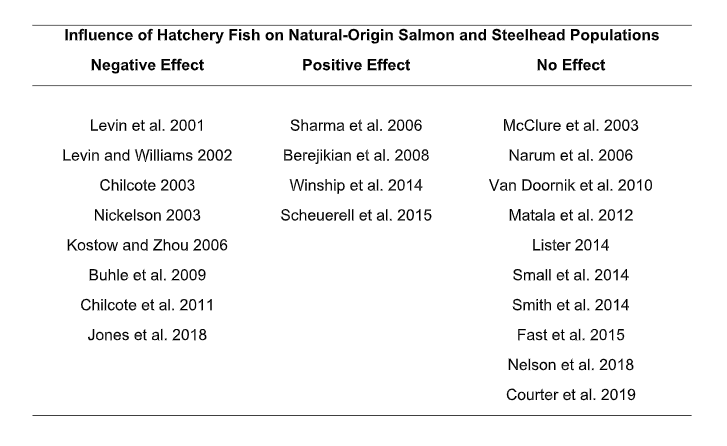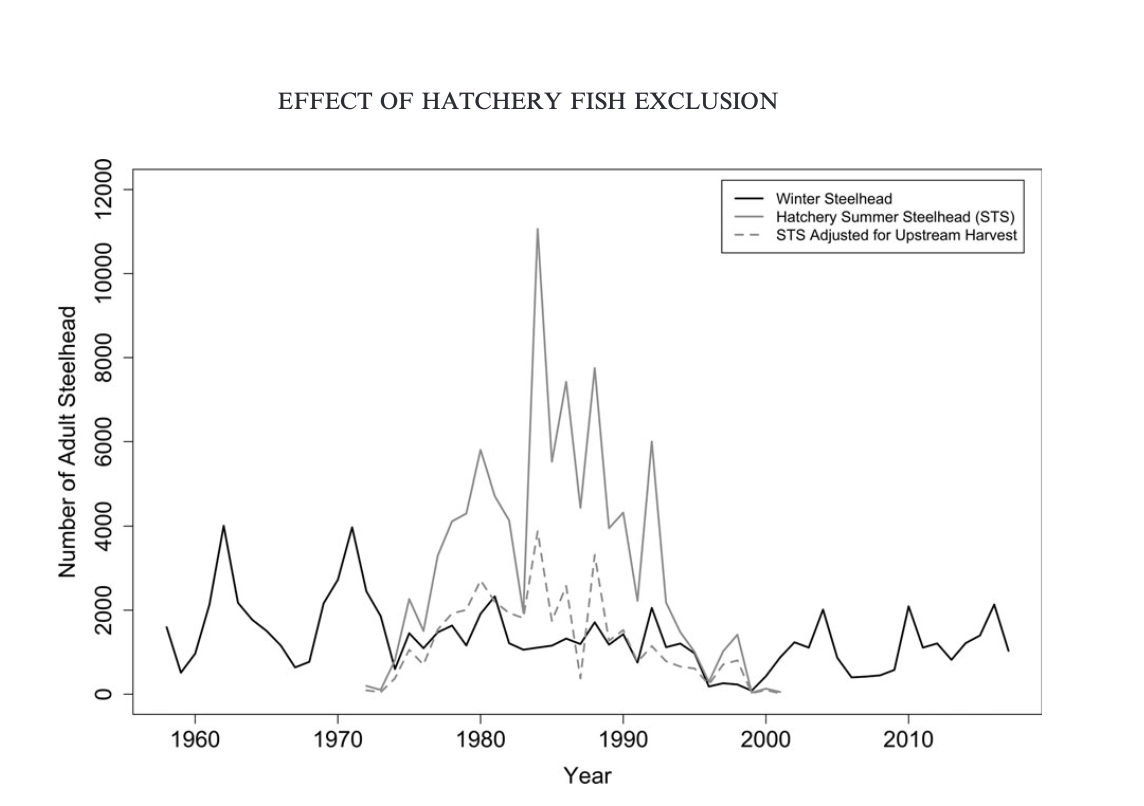Is Hatchery & Wild an anti-wild fish campaign?
Can hatchery programs be improved to better coexist with wild fish?
Yes. Updated and well-managed hatchery programs will make a significant difference in efforts to protect and restore wild fish, as well as improve cost effectiveness, return rates and quality of fish released. Many hatchery programs have undergone significant improvements and are required to have management plans approved by the federal government. However, some hatcheries remain outdated and suffer from poorly maintained facilities. In recent months, several hatchery programs have suffered devastating losses of fish costing millions of dollars that will have notable consequences on fisheries.
Where appropriate and feasible all hatchery programs should:
- Update and modernize hatchery infrastructure
- Implement broodstock programs
- Endeavor to increase harvest opportunities
In addition, regulators should look for opportunities to increase hatchery supplementation – particularly coupled with selective fisheries to harvest returning hatchery fish. And, it is important to explore opportunities to increase hatchery production in areas where wild fish are unlikely to recover due to other significant limiting factors.
Is it scientifically accurate to generalize hatchery fish impacts as always negative?
No. There is extensive science about the effects of hatchery fish on wild fish. However, many of the studies showing negative effects failed to look at the population-level and have focused on hatcheries using outdated practices and non-native broodstock. Recent studies looking at the effect of modern hatchery practices at the population-level have shown a positive impact, or no measurable effect.
The table below was provided by a scientist who is an expert in the effects of hatchery fish on wild fish. According to his analysis, in the last twenty years there are almost twice as many studies showing a positive or no quantifiable effect than those that conclude a negative effect at the population level. The table demonstrates that it is not scientifically accurate to generalize hatchery fish impacts as always negative. In fact, as the table shows, there is science that concludes hatcheries can help stabilize and increase wild fish numbers.

Do populations of wild fish in the presence of hatchery fish trend worse than wild populations under no influence hatchery fish?
No. First-hand experience shows removing hatchery fish has not resulted in increases in wild fish abundance because hatchery fish were not the principal cause of decline. Hatcheries are a tool primarily used to supplement wild populations and mitigate the portion of natural production destroyed by the loss of habitat, access barriers (dams), overharvest, hydro impacts and predation.
The first listings of endangered salmon and steelhead stocks occurred in the early 1990s. Since then a lot of work effort and money has been spent to reverse their decline and while some of those efforts have been successful, society is only willing to go so far. The factors that led to the declines and made hatcheries necessary in the first place are likely to persist, requiring the continued use of hatcheries for mitigation.

Have studies identified specific factors, other than hatchery fish, that led to the decline of wild fish?
Yes. A recent peer reviewed study from the Clackamas River shows that factors other than hatchery fish were the real problem. According to the study “… spill at North Fork Dam, the gateway to the upper Clackamas Basin, and Pacific Decadal Oscillation (an index of ocean conditions) were both negatively associated with winter steelhead recruitment.” Moreover, winter steelhead abundance in the upper Clackamas Basin failed to rebound to abundances observed in years prior to the hatchery program, and fluctuations in winter steelhead abundance were correlated with other regional winter steelhead stocks.” Removing hatchery fish could not and did not fix the problem.
The removal of hatchery fish did, however, needlessly end a popular summer steelhead fishery in Oregon. A gateway fishery that created many life-long steelhead anglers and provided a welcomed boost to the rural economy of the area.
Do hatchery salmon and steelhead eat wild salmon and steelhead?
No. Studies show hatchery and wild fish largely have the same diet in the natural environment. There is no evidence that hatchery salmon or steelhead actively feed on wild salmon or steelhead of the same age group.
Are properly implemented broodstock hatchery programs good for wild fish?
Yes. Evidence shows that properly developed and implemented broodstock programs can increase harvest opportunity and not harm wild fish populations. In fact, broodstock programs have been used successfully to reestablish extinct populations and save wild runs.
Should the goals for hatcheries and wild fish be different?
Yes. In the short-term the goal of hatchery supplementation programs is to provide abundant harvestable fisheries and help amplify wild populations. The long-term goal is to reestablish abundant runs of naturally produced self-sustaining populations of salmon and steelhead returning to our Northwest streams, wherever possible.
Are hatcheries to blame for the decline of wild fish?
No. Habitat destruction, access barriers, water pollution, predation and non-selective over-harvest are the main reasons for their decline. It is imperative to change the paradigm and not scapegoat hatchery fish as the problem while allowing society to keep practicing the same growth and poor land and water use policies that brought our endangered wild fish populations to this point in the first place. Hatchery practices have improved significantly in recent decades – we need to see similar progress addressing the major factors limiting wild fish recovery.
Can adult hatchery fish increase nutrients within a watershed?
Yes. Fish recovery experts have long recognized a significant reduction of marine derived nutrients (MDN) in low nutrient (oligotrophic) streams throughout the northwest caused by fewer naturally spawning fish in the system. Hatchery fish carcasses help increase the level of MDN which increases food availability and subsequent survival of juvenile salmon and steelhead and improves the overall health of the ecosystem.
Is it true that some wild fish advocacy groups and government programs benefit financially from an anti-hatchery agenda?
Yes. These groups benefit financially from their anti-hatchery narrative by securing public funding – including through procedural lawsuits with no on-the-ground benefit to wild fish – and private donations to support their campaigns and organizations. They have been successful at furthering their agenda by cherry-picking scientific findings that support their anti-hatchery argument while ignoring science that does not. Their propaganda intentionally misleads the public, and policy makers, about the magnitude of potential negative effects of hatcheries.
These groups have a philosophical belief about the best way to sustain wild fish populations that does not include the use of hatcheries. And it’s important to note fisheries, especially consumptive fisheries, are not important to them. They are ready, and working toward, making our rivers into museums for wild fish. Unfortunately, their worldview ignores the fact that mortalities to wild fish will continue, including through harvest in international and treaty-reserved fisheries.
Can hatchery salmon be produced that enhance the numbers of their wild cousins?
Yes. There are numerous examples where hatchery fish have enhanced wild numbers, and in some cases, saved wild fish from extinction. We have listed some of those examples here.
Are the majority of salmon and steelhead harvested in Oregon and Washington from hatcheries?
Do agency fishery scientists and policy makers recognize hatcheries as an important tool in wild fish recovery?
Are all hatchery programs, past and present, good for wild fish?
No. Studies show segregated hatchery programs, especially those that rely on out-of-basin stocks, can have an adverse effect on naturally produced fish. However, with proper controls those effects can, and should, be minimized.
H&WC advocates for hatchery programs utilizing best practices that produce fish fit for the natural environment and reduce potential effects on naturally produced populations. Studies have shown that properly designed and managed hatchery programs can help increase naturally produced fish numbers
Do some advocacy groups, researchers and regulatory agency personnel seem to generally view hatcheries as bad?
Yes. They have a philosophical belief about the best way to sustain fish populations and fisheries, especially consumptive fisheries, are not important to them. Their strategy is to cherry pick scientific findings that support their biased policy preference, thereby misleading the public and policy makers about the magnitude of potential negative effects of hatcheries. These same advocacy groups and researchers also benefit financially from their anti- hatchery narrative by securing public funding and private donations to support their campaigns and research efforts that align with their biased personal beliefs.
Do fish farms and hatcheries pose the same threat to naturally produced fish?
No. There are significant differences between industrial fish farms and hatcheries.
Fish farms are large floating net pen facilities in open water that typically raise non-native fish. There have been several instances of accidental releases of non-native fish. It is well-documented that the net pen fish often have serious disease and parasite issues that could be transferred to naturally produced and hatchery fish. Fish farms put naturally produced and hatchery fish at risk and should not be allowed.
Hatcheries are land based and follow strict guidelines for water quality, parasite and disease control. Hatcheries are highly regulated and must meet Federal and State requirements, and properly managed do not pose a disease or parasite risk to naturally produced fish.
Does H&WC support the use of industrial fish farms?
No. H&WC strongly opposes the use of floating net pen industrial fish farms in open water. Fish farms present serious risk of diseases, pollution, release of non-native fish by escapement or equipment failure, all of which pose potential harm to naturally produced and hatchery fish.
Have legal actions taken by anti-hatchery groups resulted in lost broodstock opportunities and fewer hatchery releases?
Yes. As an example – The Native Fish Society’s “Save Sandy Salmon” campaign takes credit for an Oregon District Court ruling that wild salmon and steelhead can no longer be collected for hatchery broodstock in the Sandy and upper Willamette tributaries. The legal precedent from this case was utilized to reform hatchery programs in Puget Sound and the McKenzie, Trinity and Mad Rivers.
According to the NFS, “The legal precedent set on the Sandy River resulted in 1 million fewer hatchery salmon and steelhead planted annually in Oregon and Washington rivers.”
